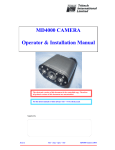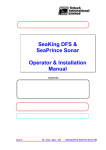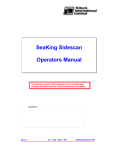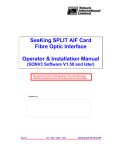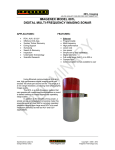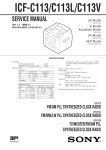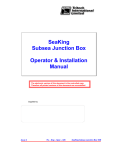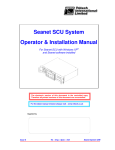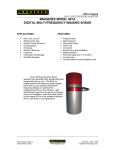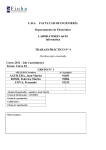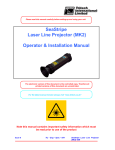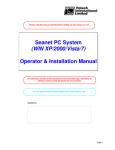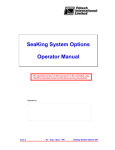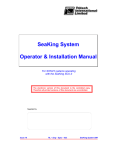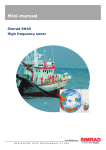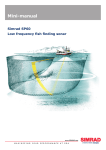Download Super SeaKing DFP, SeaKing DFP & SeaPrince Profiler
Transcript
Super SeaKing DFP, SeaKing DFP & SeaPrince Profiler Operator & Installation Manual The electronic version of this document is the controlled copy. Therefore all printed versions of this document are uncontrolled. Supplied by Issue 5 TIL – Eng – Spec – 038 Super SeaKing & SeaKing DFP & SeaPrince Profiler OIM COPYRIGHT © Tritech International Ltd The copyright in this document is the property of Tritech International Limited. The document is supplied by Tritech International Limited on the understanding that it may not be copied, used, or disclosed to others except as authorised in writing by Tritech International Limited. Tritech International Limited reserved the right to change, modify and update designs and specifications as part of their ongoing product development programme. Tritech International Ltd Super SeaKing & SeaKing DFP & SeaPrince Profiler OIM Handling of Electrostatic-Sensitive Devices 5 Safety Statements 7 Technical Support 7 Super Seaking and SEAKING DFP/SFP Head INTRODUCTION 8 Head Installation 9 Subsea sensor Electrical Installation 9 PROFILER Head Subsea Interconnect Cabling 10 dual head profiler installation 11 SEAKING Communication Configuration 12 Ground Fault Monitoring Equipment 12 mechanical installation 12 Using The DFP / SFP PROFILER 13 SUPER SEAKING and SEAKING DFP profiling Sonar Operating Notes 14 Screen Display and Controls ............................................................................................. 14 setting up the profiler configuration 15 Maintenance of The SEAKING Head 16 Trouble Shooting 16 Symptoms:......................................................................................................................... 16 SEAKING SCU Head Status Codes ................................................................................. 17 Ground Fault Monitoring Equipment ................................................................................. 17 Super Seaking DFP Specification 17 SeaKing DFP Specification: Aluminium Body 18 SeaKing DFP Specification: Stainless Steel (Light Weight) 19 SeaPrince SFP Specification 20 Issue 5 TIL – Eng – Spec – 038 Page 4 of 20 Tritech International Ltd Super SeaKing & SeaKing DFP & SeaPrince Profiler OIM Handling of Electrostatic-Sensitive Devices Attention Observe Precautions for handling Electrostatic Devices Caution Handling of Electrostatic-Sensitive Devices Certain semiconductor devices used in the equipment are liable to damage due to static voltages. Observe the following precautions when handling these devices in their unterminated state, or sub-units containing these devices: • Persons removing sub-units from any equipment using electrostatic sensitive devices must be earthed by a wrist strap via a 1MΩ resistor to a suitable discharge reference point within the equipment. • Soldering irons used during any repairs must be low voltage types with earthed tips and isolated from the Mains voltage by a double insulated transformer. Care should be taken soldering any point that may have a charge stored. • Outer clothing worn must be unable to generate static charges. • Printed Circuit Boards (PCBs) fitted with electrostatic sensitive devices must be stored and transported in appropriate anti-static bags/containers. F110.0 Issue 5 TIL – Eng – Spec – 038 Page 5 of 20 Tritech International Ltd Super SeaKing & SeaKing DFP & SeaPrince Profiler OIM Warranty Statement Tritech International Limited herein after referred to as TIL TIL warrants that at the time of shipment all products shall be free from defects in material and workmanship and suitable for the purpose specified in the product literature. The unit/system warranty commences immediately from the date of customer acceptance and runs for a period of 365 days. Customer acceptance will always be deemed to have occurred within 72 hours of delivery. Note: Any customer acceptance testing (if applicable) must be performed at either TIL premises or at one of their approved distributors unless mutually agreed in writing prior to despatch. Conditions: These include, but are not limited to, the following: 1 The warranty is only deemed to be valid if the equipment was sold through TIL or one of its approved distributors. 2 The equipment must have been installed and commissioned in strict accordance with approved technical standards and specifications and for the purpose that the system was designed. 3 The warranty is not transferable, except or as applies to Purchaser first then to client. 4 TIL must be notified immediately (in writing) of any suspected defect and if advised by TIL, the equipment subject to the defect shall be returned by the customer to TIL, via a suitable mode of transportation and shall be freight paid. 5 The warranty does not apply to defects that have been caused by failure to follow the recommended installation or maintenance procedures. Or defects resulting from normal wear & tear, incorrect operation, fire, water ingress, lightning damage or fluctuations in vehicles supply voltages, or from any other circumstances that may arise after delivery that is out with the control of TIL. (Note: The warranty does not apply in the event where a defect has been caused by isolation incompatibilities.) 6 The warranty does not cover the transportation of personnel and per diem allowances relating to any repair or replacement. 7 The warranty does not cover any direct, indirect, punitive, special consequential damages or any damages whatsoever arising out of or connected with misuse of this product. 8 Any equipment or parts returned under warranty provisions will be returned to the customer freight prepaid by TIL 9 The warranty shall become invalid if the customer attempts to repair or modify the equipment without appropriate written authority being first received from TIL. 10 TIL retains the sole right to accept or reject any warranty claim. 11 Each product is carefully examined and checked before it is shipped. It should therefore be visually and operationally checked as soon as it is received. If it is damaged in anyway, a claim should be filed with the courier and TIL notified of the damage. Note: TIL reserve the right to change specifications at any time without notice and without any obligation to incorporate new features in instruments previously sold. Note: If the instrument is not covered by warranty, or if it is determined that the fault is caused by misuse, repair will be billed to the customer, and an estimate submitted for customer approval before the commencement of repairs. F167.1 Issue 5 TIL – Eng – Spec – 038 Page 6 of 20 Tritech International Ltd Super SeaKing & SeaKing DFP & SeaPrince Profiler OIM Safety Statements Throughout the manual certain safety or operational related comments and requirements will be highlighted to the operator by indications identified by the adjacent symbol and text. Caution! Technical Support Contact your local agent or Tritech International Ltd Mail Tritech International Ltd. Peregrine Road, Westhill Business Park, Westhill, Aberdeen, AB32 6JL, UK Telephone ++44 (0)1224 744111 Fax ++44 (0)1224 741771 Email [email protected] Web www.tritech.co.uk An out-of-hours emergency number is available by calling the above telephone number If you have cause to use our Technical Support service, please ensure that you have the following details at hand prior to calling: • • • System Serial Number (if applicable) Fault Description Any remedial action implemented Due to the expansion of equipment capabilities and the fact that new sub-modules are continually being introduced, this manual cannot detail every aspect of the operation. Issue 5 TIL – Eng – Spec – 038 Page 7 of 20 Tritech International Ltd Super SeaKing & SeaKing DFP & SeaPrince Profiler OIM SUPER SEAKING AND SEAKING DFP/SFP HEAD INTRODUCTION The SUPER SEAKING, the SEAKING Dual Frequency and SEAPRINCE Single Frequency scanning heads operate over a 360 degree scanning field. The operating frequencies of the Super Seaking DFP are 600kHz or 1100kHz, giving ranges of up to 80m. The operating frequencies of the Seaking DFP are 580kHz or 1200kHz and Sea Prince SFP is 675kHz.The heads are available in standard ‘Vertical’ body configuration, (with tall boot for narrow beam transducer). The heads are able to continuously, or part-scan the full 360-degree sector in either direction. There can be one or more sonar or profiler heads used in a system. The profiler heads can operate in various scan modes depending on user set-up in the SCU. The transducer head and motor are pressure compensated within an oil-filled semi-rigid boot. The super Seaking has been designed with a hard boot, which offers increased protection. The electronics are contained within the body tube in dry air at one atmosphere pressure. The sonar body is machined from aluminium alloy, and has a hard-anodised coating. A water-block is fastened to the body tube of the head, and provides a 4000metre rated pressure bulkhead. The 6-way underwater connector is secured to the water-block fitted to the body tube using four cap screws; this connects to the pins on the PSU/COMMS PCB. An O-ring seals the connector to the water-block. The SUPER SEAKING DFP, the SEAKING DFP and SEAPRINCE SFP heads have the facility for the Time Variable Gain (TVG) slope to be set-up from the Seaking Surface Control Unit (Seaking or SeaNet SCU), to specific user requirements. The SUPER SEAKING DFP, the SEAKING DFS/DFP and SEAPRINCE SFS and SFP have improved features over the Series 2 Sonar and Profiler heads, these are outlined below. • Scan rate The Seaking / SeaPrince head can achieve a scan rate of up to 180° per second - the actual physical acoustic limit. The scan rate of the Seaking range of heads are significantly faster, particularly on short ranges, than the Series 2 head, and may be up to 10 times faster on ranges up to 30 metres irrespective of the scan speed selected. This gives faster target acquisition, and helps in obstacle avoidance. • Dual Frequency Operation The Super Seaking and Seaking DFP/DFS can use up to two operating frequencies - one giving long range target acquisition characteristics and the other giving shorter range imaging capability. It is effectively two sonars in a single housing. The lower frequency operation is extremely useful for long-range target acquisition - again, important when avoiding potential targets. The higher frequency is then used for high definition work. Each of the two operating frequencies may be offset from the centre frequency e.g. the 580 kHz transducer may be digitally tuned between 560 and 600 kHz. This can be very useful if you have another piece of equipment with a similar operating frequency or if 580 kHz is a harmonic of the operating frequency of another piece of equipment. These frequency alterations are remotely carried out using the Seaking SCU unit. • Protected transducer The Seaking DFS/DFP has a semi-rigid oil-filled plastic boot. The Super Seaking has a rigid oil-filled boot that offers a much greater protection than previous models, to the sonar transducer if subjected to impact. Should an excessive impact occur then damage the transducer or stepper motor. The unit has no rotating seals to be damaged or wear. • Electrical Connection The SUPER SEAKING, SEAKING and SEAPRINCE heads use the same 6 way U/W Connector as per Series 2 Sonar Heads. Issue 5 TIL – Eng – Spec – 038 Page 8 of 20 Tritech International Ltd Super SeaKing & SeaKing DFP & SeaPrince Profiler OIM HEAD INSTALLATION The SUPER SEAKING DFP and SEAKING DFP\SFP heads are supplied with their own water-block / connector with a length of polyurethane jacketed cable (profiler - 3metres length). Depending on the specification of the system, this cable will either need to be terminated to a suitable connector appropriate to the operators equipment, or may be supplied with a cable assembly to one or more additional connectors. The water-block is fastened to the body tube of the head, and provides a 4000metre rated pressure bulkhead. This will protect the electronics from water ingress in case the connector is damaged or fitted incorrectly. The connector may be disconnected from the heads by unscrewing the four securing screws and removing the connector from the water-block. Caution ! It is not necessary to remove the water block when removing the connector or taking the head apart. Whilst the connector is removed from the head, the blanking plugs supplied should be fitted to prevent the ingress of dirt or moisture. SUBSEA SENSOR ELECTRICAL INSTALLATION The Super Seaking and Seaking ranges of Subsea Sensors are designed to work from a smoothed DC power supply of 18v-36v DC (Absolute Maximum 36v DC). If using a rectified transformer PSU, the output of the PSU must have a filter capacitor of not less than 470μF, for each head being powered. If an unregulated PSU is used, then make sure that the voltage value measured at the head is in the range 18-36v DC, in power on/off and running conditions. If powering the head(s) down a long lead or umbilical, the maximum recommended loop resistance of the power line must not exceed 10Ω for one head, 5Ω for two heads, and 3Ω for three heads. Issue 5 Caution ! Caution ! If the supplied voltage is less than 18v dc the head may not operate l Never try to make the Super SeaKing, SeaKing or SeaPrince system heads work down a long cable by increasing the PSU output voltage above 36v DC. A 48VDC PSU Option is available that will allow operation up to 70VDC for long line applications. TIL – Eng – Spec – 038 Page 9 of 20 Tritech International Ltd Super SeaKing & SeaKing DFP & SeaPrince Profiler OIM PROFILER HEAD SUBSEA INTERCONNECT CABLING The Underwater Connector supplied is 6 way; the wiring code is shown below. Caution ! The numbers shown relate to all schematic diagrams, (not a DIN style format). Fig. 1.0 ST 6 Way Underwater Connector Wiring Configuration Fig. 1.1 SeaKing Communication Wiring Diagram Issue 5 TIL – Eng – Spec – 038 Page 10 of 20 Tritech International Ltd Super SeaKing & SeaKing DFP & SeaPrince Profiler OIM DUAL HEAD PROFILER INSTALLATION For a dual head installation, the MAIN connector port on each should be connected to a common Communications Pair (pins 1&2) and common Supply and Ground (pins 3&4) from the subsea junction box - See diagram below. Pin 5 of the connector is allocated as a “Dual Head Sync” line on the profiler. This is in common with the pin 5 of Series-2 Profiler heads. The pin 5 of the Master must link through to the pin 5 of the Slave to enable Scan and Ping Synchronisation between heads. Caution ! The pin 5 line of the profilers MUST be isolated and not linked through to the pin 5 of any other devices such as Sonar’s or Bathymetric bottles that are attached to the same network. MASTER MAIN AUX Comms Comms +24v DC 0v DC PIN 5 Dual Head Pair link SLAVE AUX MAIN Fig. 1.2 Dual Head System interconnect diagram Issue 5 TIL – Eng – Spec – 038 Page 11 of 20 Tritech International Ltd Super SeaKing & SeaKing DFP & SeaPrince Profiler OIM SEAKING COMMUNICATION CONFIGURATION All SEAKING systems communicate using ‘ARCNET’ multi-drop, networked communications on the twisted cable pair. It is possible to interface the ARCNET to wideband multiplexor systems, contact Tritech for details. Caution ! The ’ARCNET’ does require a surface and subsea termination resistor to be fitted at each end of the umbilical. Normally this is supplied fitted within the D connector at the surface, and is left for the user to fit at the subsea end in a convenient ‘J’ box. This is the easiest system to adopt when using multiple sensors on the network. However if just one device is in use it may be more convenient to fit the resistor inside the subsea unit. Devices fitted with a termination resistor should be appropriately labelled, but the user can check by measuring the resistance between pins 1 and 2 on the water block connector. The SEAKING SCU, sonar and profiler heads cannot be used with RS-232 / RS-485 AIF Cards as used in earlier WINSON based SCU-3 systems, and must be used with AIFSEAKING ARCNET (AIFBV3) Cards. RS-232/RS-485 Series 2 Sonar, Profiler and other heads cannot be directly used with SEAKING systems. Contact Tritech or local agent for details. GROUND FAULT MONITORING EQUIPMENT The power supply within SEAKING subsea heads includes an electrically isolated DC-DC converter front end; there is a small capacitive connection to the sonar chassis which should not noticeably affect any impressed current ground fault indicator (GFI) equipment MECHANICAL INSTALLATION Caution ! Although the sonar and profiling heads are rugged, they should be handled with care, particularly the connector and transducer heads. It is strongly recommended that a substantial guard be fitted over the scanning heads to protect the transducer and drive electronics from impact damage. A SUPER SEAKING DFP, SEAKING DFP or SEAPRINCE SFP head should be secured by clamping on the cylindrical body section such that the transducer head is unimpeded or shielded. Any metallic clamps should be electrically insulated from the sonar body by means of rubber or plastic strips or mount brackets of at least 3-mm thickness and extending at least 3 mm beyond the clamp boundary to reduce any galvanic corrosion effect. Non-metallic clamps are preferable: if metallic clamps are used (especially if they are other than aluminium) they should be painted or lacquered with at least two or three coatings. Brass or bronze materials should be avoided unless they have aluminium content as their copper content cause’s serious corrosion problems when in proximity to aluminium components. Care should be taken to mount profiling heads to ensure that they are mounted as close to the true horizontal as possible in relation to the trim position of the vehicle. The front filling plug and red LED should be pointed directly downwards in the case of profiling sonars. This is important since errors in the head alignment can give rise to unreliable results. Issue 5 TIL – Eng – Spec – 038 Page 12 of 20 Tritech International Ltd Super SeaKing & SeaKing DFP & SeaPrince Profiler OIM USING THE DFP / SFP PROFILER On completion of installation of the profiler(s) on a vehicle, they can be tested in air by powering up the system and observing that the red LED illuminates as the head scans through the ahead direction. Please Note that this can not be done if a composite transducer is used. The Profiler heads can be run in Single or Dual head modes. The head has a minimum lockout range of 0.3 metres and will not display returns below this range. The lockout value can be adjusted in the Profiler ‘Tools’ menu accessible through the ‘Spanner’ icon on the Profiler screen display area. A dual head system will have 2 individual heads connected, each with separate node numbers; typically 20(Master) and 21(Slave). The head that is programmed with the lowest node number of the pair is effectively the Master (or controlling head). Both nodes can be run in single head operation. The head enable flags (Master and Slave) in the Profiler ’Tools’ menu can be used to enable/disable heads on the network. With only the Node 21, Slave head connected to the network, the Slave flag should be enabled and the Master flag should be disabled in the ‘Tools’ menu - and vice-versa for a Master head only connected. If a head is enabled and is not physically connected, an error status message will flash onscreen to inform the operator that a profiler head has not been detected. Any unconnected heads should therefore be disabled to prevent interruptions. A Synchronisation link is setup between a Dual Head pair on the pin 5 line. When pin 5 is linked, the Master head is responsible for taking control of the pair and establishing Scan and Ping syncs if these have been enabled in the Profiler ‘Tools’ menu. Experience with the profiler(s) will enable the operator to be able to quickly and effectively set the "Gain" control to maximise the performance capabilities of the head. An Adaptive Gain Control is provided in the ‘Tools’ menu to further optimise performance. This control should be switched off when working in close environments such as Test-tanks. In open conditions, the AGC function can become a very useful tool. The operator can set a base Gain using the ‘Gain’ dial and then not worry about adjusting this control when conditions start to vary slightly. The AGC will auto increment/decrement the Gain level to a pre-determined optimum level. The “Threshold” control is not functional for profiling applications. There are 4 range resolutions available; Low, Medium, High and Ultimate, selected from the Main Menu. As you increase the resolution from Low to Medium to High to Ultimate, the sonar display will plot more points within the scan. Adjusting the resolution will vary the mechanical step size from 1.8° to 1.35° to 0.9° to 0.45° as resolution is increased. Use of a lower resolution will give faster scan speeds, but with coarser detail. The Time Variable Gain (TVG) SLOPE may be adjusted to improve sonar return balance on longer ranges. Only use the SLOPE control after setting the main gain control to achieve good results close to the profiler head. Issue 5 TIL – Eng – Spec – 038 Page 13 of 20 Tritech International Ltd Super SeaKing & SeaKing DFP & SeaPrince Profiler OIM SUPER SEAKING AND SEAKING DFP PROFILING SONAR OPERATING NOTES Screen Display and Controls The Main Areas of the Profiler Display are identified below: Main Sonar Controls Profiler Toolbar Range Scale Display Header ‘Tools’ menu Low/High Cursor (Spanner Icon) Frequency Co-ordinates (DFP Only) Profiler Pipetracker Resolution Pause interface display Issue 5 TIL – Eng – Spec – 038 ‘Menu’ Options ‘Log’ Options Screen Freeze Page 14 of 20 Tritech International Ltd Super SeaKing & SeaKing DFP & SeaPrince Profiler OIM SETTING UP THE PROFILER CONFIGURATION These Profiler Setup controls are automatically remembered if the Sonar system is shut down using the ‘Exit’ command prior to powering off. Click the Toolbar ‘Spanner’ Icon to access setup options. Click this button to Reset system to default controls Operating Range Units M=Metres, Ft=Feet, Yd=Yards, Fm=Fathoms. Click this control to cycle through available Range Units. Disable this control if profiler is mounted boot forward. Enable ‘Inverted Head’ (‘x’) if transducer is mounted reversed. Enable ‘More Options’ check box to display less frequently used flags in bottom menu, such as ‘Pipetracker’ and ‘Manual Trigger’. Operating Frequency Adjust Slide Bar. Allows the sonar operating frequency to be shifted by +/20kHz. ‘F Reset’ button resets frequency to normal. Scan Direction select. ‘Scan Right’ and ‘Scan Left’ to scan in one direction only. ‘Alternate Scan’ will scan L->R, R->L, alternately. Adaptive Gain Control. Applies automatic refining of manual Gain setting. Switch off to apply manual Gain control setting only. AGC will always act on the maximum received echo and as a result the ‘1’st Return’ check box will de-activate when AGC ‘1’st Return’ (Disabled when AGC on). If ‘on’ will sample and plot the first peak received echo. The next step and ping is then activated immediately. When ‘off’, samples are taken over full range and first peak echo plotted (default ON, for faster scans). Positional setup (X, Y and R offsets) of Master & Slave heads. ‘En Master’ and ‘En Slave’ - Switch on/off Master and Slave heads. Switch off any heads that are not connected to the network to prevent interruptions. ‘Manual Trigger’ enable. When ‘ON’, the ‘Trig’ button will be active on the profiler display bar and the profiler(s) will switch to standby mode. Depressing the ‘Trig’ button will trigger the head to complete one full scan. Pipetracker Serial Input. Display on/off and input of pipe diameter AGC Threshold. Adjustable by +/15db to increase / decrease level of AGC applied. Issue 5 ‘‘Maximum Return’ (Disabled when ‘1’st Ret’ on). Plots the maximum (strongest) echo received. This control is particularly useful in cluttered test tank operations where tank wall echoes are stronger than detectable clutter echoes. Dual Head Controls (normally ‘ON’ for DHP application). ‘Scan Sync’ synchronises Master and Slave at scan start. ‘Ping Sync’ enables alternate pinging between heads (to be used when overlapping scans will cause interference. (Individual Freq.) Lockout Ranges. Echoes received below this value are ignored. 580kHz >400mm 1210kHz >200mm When ‘ON’, Slave direction is taken as the mirror of the Master scan direction setting. TIL – Eng – Spec – 038 Page 15 of 20 Tritech International Ltd Super SeaKing & SeaKing DFP & SeaPrince Profiler OIM MAINTENANCE OF THE SEAKING HEAD There are no user-serviceable parts in the sonar or profiling heads and no components requiring routine maintenance. It is recommended that profiling heads be rinsed down with fresh water after each dive and especially if the unit is not going to be used for extended periods. Although the anodised aluminium components are very resistant to corrosion, using fresh water is a simple way of minimising the chance of corrosion. Wherever possible, avoid any prolonged exposure to extreme climatic and weathering conditions to reduce any ageing effects on the protective boot and connectors. TROUBLE SHOOTING Symptoms: 1 Continuous Status "No Comms" message. This indicates that there is no communication with the device flagged. (Suffix “M” is Master profiler, Suffix “S” is Slave profiler Check the power and communications links to the Profiler head for continuity and for correct polarity, voltage and ensure that the power supply can provide sufficient current to power all devices. If a cable flood is suspected, then the conductors will need to be insulation tested; the sonar heads and SEAKING SCU must be disconnected as described in the Service Manual. Caution ! This is especially critical If a cable insulation tester is used to check resistance between conductors, as serious damage to the Scanning/Profiling heads and SEAKING SCU will occur if the correct procedure is not followed. 2 Continuous Status “ Version Unknown” message, with no audible alarm Click the profiler ‘Tools’ (spanner icon) and check Master and /or Slave heads enabled. 3 Other Status Messages. Refer to the SEAKING SCU Head Status Codes 4 Profiler head rotates but no data points plotted Check the gain control is responding and not set at a minimum. Listen to profiler head in air. If it "clicks" audibly then the transmitter circuit is OK. Click the Profiler ‘Tools’ menu (Spanner Icon) - [Reset Controls] button to return to default system settings. Issue 5 TIL – Eng – Spec – 038 Page 16 of 20 Tritech International Ltd Super SeaKing & SeaKing DFP & SeaPrince Profiler OIM SEAKING SCU Head Status Codes Code Version Unknown Busy Possible Reason or Fault giving Error Code Sonar or Profiler head not powered up, or comms fault. Head is centring on power-up, or head has lost centre during scan. Ground Fault Monitoring Equipment The power supply within SEAKING DFS sonar and DFP profiler heads includes an electrically isolated DC-DC converter front end, There is a small capacitive connection to the sonar chassis which should not noticeably affect any impressed current ground fault indicator (GFI) equipment SEAKING DFS Sonar Head Data Sheet. Super Seaking DFP Specification Overall length Body tube diameter Maximum diameter Weight in air Weight in water Frequency Range resolution Mechanical resolution Maximum range Scan size Depth rating Materials Finish Operating temperature Storage temperature Power requirements Data communications Drive capability (ARCNET only) Isolation (ARCNET only) 278 mm 99 mm 110 mm 3.5 kg 1.7 kg 600 kHz & 1.1MHz +/- 1mm <0.45° 80m Variable up to 360° 4000 m Aluminium alloy - HE30, RPU Hard anodised Black -10°C to +35°C -20°C to +50°C 18v-36v DC (Abs. Max. 36v DC) @ 6VA. ARCNET multi-drop 2,200 m Transformer Isolated 1500v MIN Fig. 1.3 Dimensions of Super Seaking DFP Profiler Head. Issue 5 TIL – Eng – Spec – 038 Page 17 of 20 Tritech International Ltd Super SeaKing & SeaKing DFP & SeaPrince Profiler OIM SeaKing DFP Specification: Aluminium Body Overall length Body tube diameter Maximum diameter Weight in air Weight in water Frequency Range resolution Mechanical resolution Maximum range Scan size Depth rating Materials Finish Operating temperature Storage temperature Power requirements Data communications Drive capability (ARCNET only) Isolation (ARCNET only) 242 mm 99 mm 110 mm 3.0 kg 1.4 kg See configuration sheet +/- 1mm <0.45° 300m Variable up to 360° 4000 m Aluminium alloy - HE30, RPU Hard anodised Black -10°C to +35°C -20°C to +50°C 18v-36v DC (Abs. Max. 36v DC) @ 6VA. ARCNET multi-drop 2,200 m Transformer Isolated 1500v MIN 75 mm 240 mm 99 mm 17 mm 110 mm Issue 5 TIL – Eng – Spec – 038 Page 18 of 20 Tritech International Ltd Super SeaKing & SeaKing DFP & SeaPrince Profiler OIM SeaKing DFP Specification: Stainless Steel (Light Weight) Overall length Body tube diameter Maximum diameter Weight in air Weight in water Frequency Range resolution Mechanical resolution Maximum range Scan size Depth rating Materials Finish Operating temperature Storage temperature Power requirements Data communications Drive capability (ARCNET only) Isolation (ARCNET only) 245 mm 99mm and 94mm 110 mm 5.9 kg 4.3 kg See configuration sheet +/- 1mm <0.45° 300m Variable up to 360° 4000 m Stainless Steel Polished Stainless Steel -10°C to +35°C -20°C to +50°C 18v-36v DC (Abs. Max. 36v DC) @ 6VA. ARCNET multi-drop 2,200 m Transformer Isolated 1500v MI 75 mm 99 mm 94 mm 17 mm 110 mm Issue 5 TIL – Eng – Spec – 038 Page 19 of 20 Tritech International Ltd Super SeaKing & SeaKing DFP & SeaPrince Profiler OIM SeaPrince SFP Specification Overall length Body tube diameter Maximum diameter Weight in air Weight in water Frequency Beam Size Mechanical resolution Range resolution Minimum range Maximum range Scan size Depth rating Materials Finish Operating temperature Storage temperature Power requirements Data communications Drive capability (ARCNET only) Isolation (ARCNET only) 230 mm 63 mm 70 mm 1.3 kg 0.5kg See configuration sheet 1.4° conical <0.45° ± 1.4 mm 0.4 m 30m Variable up to 360° 4000 m Aluminium alloy - HE30, RPU Hard anodised Black -10°C to +35°C -20°C to +50°C 18v-36v DC (Abs. Max. 36v DC) @ 6VA. ARCNET multi-drop 2,200 m Transformer Isolated 1500v MIN 63.0mm 230.0mm 261.0mm 70.0mm Fig 1.5 Dimensions of SeaPrince Single Frequency Profiler Head Issue 5 TIL – Eng – Spec – 038 Page 20 of 20



















